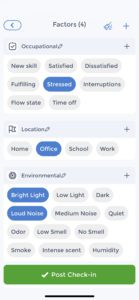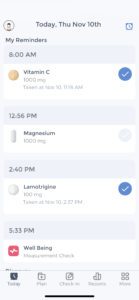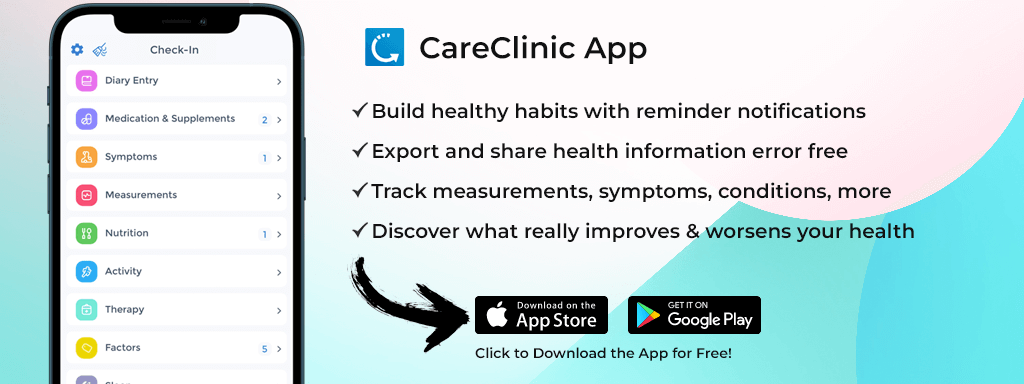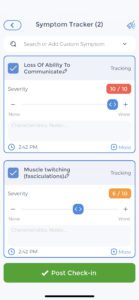
Looking for a seizure diary or epilepsy tracking app? The CareClinic app helps you track seizures, medications, symptoms, and triggers in one place. You or your caregiver can use it to log every episode in detail, including timing, duration, severity, and recovery. This information gives your doctor a complete picture between appointments and helps you spot patterns that may reduce seizure frequency. A digital seizure diary like CareClinic can also improve medication adherence, track side effects, and help you feel more in control of your care. [1][2]
Table of Contents
- Top Seizure Diary Apps Compared
- What are the different types of seizures?
- What is the difference between a seizure and epilepsy?
- What are the warning signs of a seizure?
- What is the biggest trigger for seizures?
- What is a seizure diary?
- Paper diary or digital epilepsy tracker?
- How do I use an epilepsy diary for self-monitoring?
- Tips on keeping a seizure diary
- Seizure management is crucial for people with epilepsy
Top Seizure Diary Apps Compared
Choosing the right seizure diary app can make a big difference in how well you manage epilepsy. We compared the most popular options to show why CareClinic stands out in security, customization, and medical accuracy. See how it stacks up below and decide which tool gives you the most control over your condition.
| Feature | CareClinic | Epsy | SeizureTracker |
|---|---|---|---|
| Track seizures and symptoms | ✅ Yes | ✅ Yes | ✅ Yes |
| Track medications, triggers, and recovery | ✅ Fully supported | ⚠️ Limited | ❌ Manual input only |
| Custom health modules (sleep, mood, diet) | ✅ Included | ❌ Not available | ❌ Not available |
| Privacy compliance (HIPAA / PIPEDA) | ✅ Fully compliant | ❌ Unverified | ❌ No stated policy |
| Doctor-reviewed and endorsed | ✅ Yes, by neurologists | ❌ No clinical backing | ❌ No clinical backing |
| Export reports to PDF or CSV | ✅ One-click export | ⚠️ Only via email | ⚠️ Requires manual formatting |
| Independent (no pharma affiliations) | ✅ Yes | ❌ Sponsored content | ❌ Third-party data sharing |
What are the different types of seizures?
Some common types of seizures include:
Tonic-clonic seizures (formerly known as grand mal seizures)
These are the most common types of seizure and involve a loss of consciousness. Tonic-clonic seizures usually start with a tonic phase, where the muscles stiffen, and then progress to the clonic phase, where the muscles contract and relax rhythmically.
Partial (focal) seizures
These seizures involve only a part of the brain, and the person usually remains conscious. Partial seizures can progress to tonic-clonic seizures in some cases.
Absence (petit mal) seizures
These seizures involve a brief loss of consciousness and often happen in children. Absence seizures are typically less than 15 seconds long.
Myoclonic seizures
These seizures involve muscle jerks and can happen in isolation or as part of another type of seizure. Generally, myoclonic seizures affecting the whole body are called grand myoclonus.
Atonic seizures (also known as drop attacks)
These seizures involve a sudden loss of muscle tone, which can cause the person to fall down. While atonic seizures don’t always cause loss of consciousness, they can be very dangerous, particularly if they happen while the person is walking or climbing stairs. [3][4]
Status epilepticus
This is a medical emergency that happens when someone has a seizure that lasts for more than five minutes or has multiple seizures without regaining consciousness in between. Status epilepticus can be life-threatening if not treated immediately. They can also cause brain damage.[5][6]
What is the difference between a seizure and epilepsy?
A seizure is a sudden, uncontrolled electrical disturbance in the brain. Epilepsy is a condition that causes people to have recurrent seizures. Epilepsy may be caused by a variety of factors, including brain injury, genetic conditions, and infections.[7]
What are the warning signs of a seizure?
Some common warning signs of a seizure include:
- Uncontrollable jerking movements of the arms and legs
- Stiffening of the body
- Loss of consciousness
- Confusion
- Visual disturbances
- Hallucinations
- Numbness or tingling
If you experience any of these warning signs, please seek medical attention immediately.[8]
What is the biggest trigger for seizures?
Missing medications, insomnia, anxiety, drinking, and menstruating can all be triggers of menopause, but many others can exist. Flashing lights can cause seizures, and are often less common than expected. If you have a trigger, be sure to avoid it or take extra precautions. The CareClinic app is a preferred diary app that can automatically detect and inform you about correlations between different modalities, helping you discover triggers easily. You can use it as an anxiety tracker, medication tracker, or symptom tracker, as it comes built with a multitude of Trackers and Modules (such as for Appointments, storing labs, etc).[9]
What is a seizure diary?
A seizure diary helps you monitor seizures and track changes in how often they happen or how intense they are. Many people find that using a diary makes it easier to spot patterns. This can help you manage your seizures more effectively. Your epilepsy care team can also use your diary to make better treatment decisions.
To effectively track your epilepsy, use CareClinic’s specialized monitoring features designed for your condition.
Many apps help you track seizures. You can log when they happen, how long they last, what may have triggered them, and how you felt afterward.
The CareClinic app lets you share your diary with your caregiver electronically. This is useful if you cannot attend appointments regularly. You will always have your records ready, so you can make the most of your time with your doctor.
Paper diary or digital epilepsy tracker?
While a paper diary can be kept with you at all times, it may be easier to lose track of. A paper diary involves constantly printing a PDF or using a notebook. Paper diaries may be better for some people, such as those who don’t have regular access to a device or those who prefer to write by hand.
A digital diary can be synced with your smartphone and is less likely to be lost or forgotten. Additionally, digital diaries can store a lot more health data, plot charts, allow you to quickly search specific times, and can be password protected. CareClinic is a digital seizure diary that allows you to track your seizures, triggers, and recovery times. You can also share your data with your doctor electronically, which can be helpful if you are unable to attend regular appointments.
How do I use an epilepsy diary for self-monitoring?

The severity of the seizure should also be noted, as well as any injuries suffered during the seizure. Additionally, it is important to track how long it takes to recover from a seizure and any changes in mental or physical state after a seizure.
Tracking seizures is more than just writing when they occurred, but taking note of additional information that can help you improve your outcome as well. Aura, or feeling, changes before a seizure is one example. Other things to take note of include:
- Changes in behavior
- Sleep patterns
- Dietary changes
- Stressful life events
By taking all of this into account, you can start to see patterns that may help you better manage your seizures. For example, you may notice that you have more seizures when you are sleep deprived or when you skip meals. Alternatively, you may find that certain foods trigger your seizures, in which case it is important to use a food diary together with tracking potential triggers.
If you are keeping track of your seizures electronically, you can set up reminders to log entries and export your data to share with your doctor. This can be especially helpful if you are unable to attend regular appointments.
Can you export your data to show your doctor?
Yes! If you are tracking your seizures electronically, you can set up reminders to log entries and export your data to share with your doctor. This can be especially helpful if you are unable to attend regular appointments. When exporting your data, you will need to include:
- The date range of the seizures being exported
- The format you would like the data in (e.g. PDF, CSV)
- The data you would like to export
Tap “Export” to save the file locally on your phone or to share it directly via any other app instantly.
Why the CareClinic App?
Other apps may provide similar functionality, but are generally affiliated with organizations that harvest your data and use it to advertise and share it with parties that you may not wish to share it with. CareClinic is an independent company based in Canada that complies with all security and privacy laws and does not sell your private information to organizations that may use it for malicious purposes. Additionally, CareClinic is one of the only seizure diary apps that has been reviewed and endorsed by epileptologists and neurologists.
CareClinic can help keep track of your seizures, but it is much more than that; it is a complete well-being solution that includes a stool tracker, mood tracker, and more. This allows you to track how your seizures affect other areas of your life and well-being. Freely adjust trackers and modules on or off based on your needs.
Can I use the CareClinic App even if my doctor doesn’t use it?
Yes! You can use the CareClinic App to track your seizures, triggers, and recovery times. You can print your data to share it directly with your doctor if they do not have a CareClinic account.
Tips on keeping a seizure diary

Some tips for keeping a seizure diary include:
Make sure you have a way of recording your seizures with you at all times. This could be a notebook, an app, or even a voice recorder.
Be as detailed as possible when recording your seizures. Include information on when the seizure started and ended, what happened during the seizure, how you felt afterward, and any changes in your mental or physical state.
Try to identify any patterns in your seizures. This could include triggers, times of day or month when seizures are more likely to occur, or how long it takes to recover from a seizure.
Make sure to share your seizure diary with your doctor. They will be able to use the information to help manage your condition.
Tracking your medication, medication side effects, and other medical appointments is important. Medications, including anticonvulsants, anti-seizure medications, and antiepileptic drugs, can help prevent seizures. Side effects from these drugs can include drowsiness, dizziness, and problems with coordination. Be sure to talk to your doctor about any side effects you experience.
It is also important to keep track of any medical appointments, including doctor’s appointments, therapy appointments, and seizures. These will help you keep track of your progress and ensure that you are getting the care you need.
Post-seizure, it is common to feel tired and disoriented. You may also have a headache (record it in the app or use a printable PDF), muscle pain, and nausea. It is important to rest after a seizure and not drink alcohol until you have fully recovered.
Seizures can be unpredictable and often happen without warning. By keeping a seizure diary, you can be better prepared for when they do occur.
Learn more through the Epilepsy Foundation
The Epilepsy Foundation can provide information and resources about seizures and epilepsy. They also offer support groups for people with epilepsy and their families. The Foundation can also connect you with other people with epilepsy who understand what you are going through. If you or someone you know has epilepsy, the Epilepsy Foundation can help.
Seizure management is crucial for people with epilepsy

This can be done by keeping a seizure diary. A seizure diary app is a tool that can help people with epilepsy and their caregivers track progress and identify patterns.
Think of the CareClinic epilepsy app as a personal health assistant that can help manage day-to-day life with epilepsy by providing a space to track important health information in one place.
Download CareClinic now and find your way forward.
References
- “Keeping a seizure diary – Epilepsy Action”. https://www.epilepsy.org.uk/living/keeping-a-seizure-diary
- “Seizure diaries | Epilepsy Society”. https://epilepsysociety.org.uk/about-epilepsy/epileptic-seizures/seizure-diaries
- “Using Seizure Diaries | Epilepsy Foundation”. https://www.epilepsy.com/manage/tracking/seizure-diaries
- “5 reasons why you should keep an Epilepsy Seizure Diary – Neuraxpharm”. https://www.neuraxpharm.com/blog/5-reasons-why-you-should-keep-an-epilepsy-seizure-diary
- “Seizure_types”. https://www.bionity.com/en/encyclopedia/Seizure_types.html
- “Seizure”. https://en.wikipedia.org/wiki/Seizure
- “Causes of Epilepsy | Epilepsy Foundation”. https://www.epilepsy.com/causes
- “Seizure Signs to Not Ignore”. https://health.clevelandclinic.org/warning-signs-of-a-seizure
- “Seizure Triggers | Epilepsy Foundation”. https://www.epilepsy.com/what-is-epilepsy/seizure-triggers
- “Current norms and practices in using a seizure diary for managing epilepsy: A scoping review – PMC”. https://pmc.ncbi.nlm.nih.gov/articles/PMC9575367/



